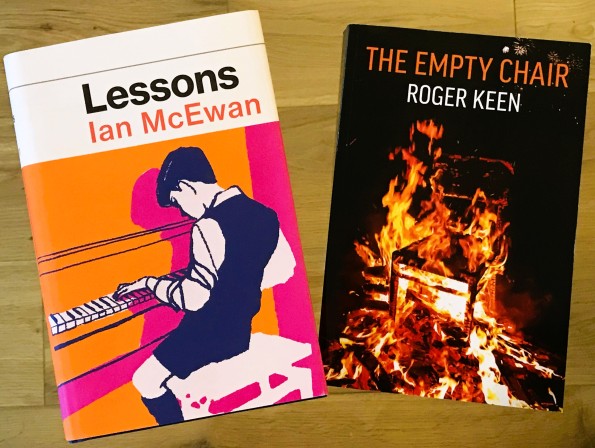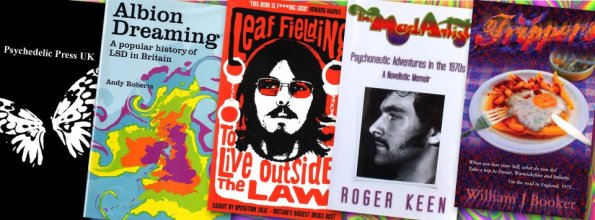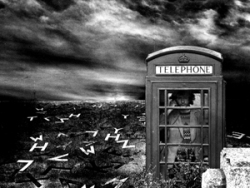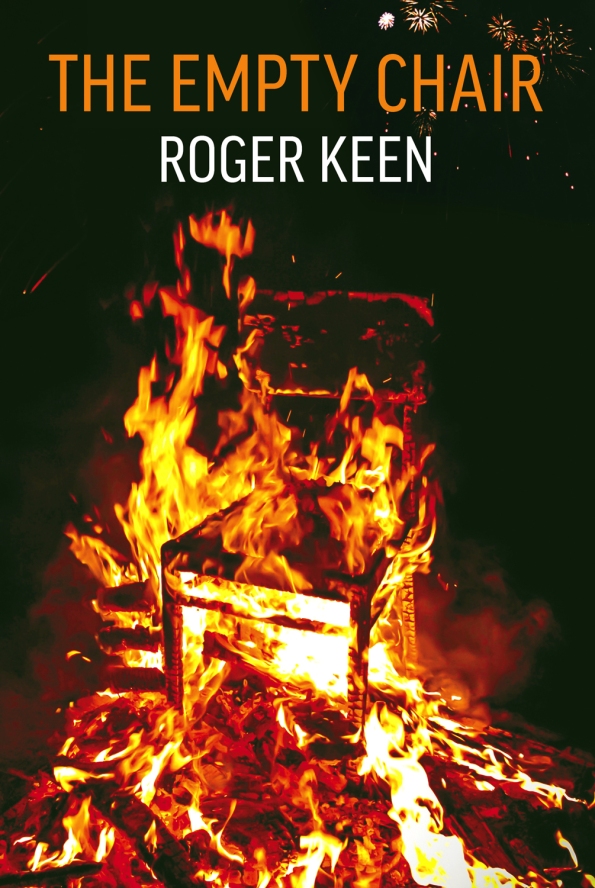Archive
The Strange Days of the Mid-1970s
It was fortuitous that publisher Trevor Denyer happened to see my trippy photomontage ‘Man of Letters’ from my time at art college on my Facebook page The Mad Artist, publicising the memoir that details those years. He came to use it for the cover of his Strange Days – Midnight Street Anthology 4, featuring stories by many writer friends, including Simon Clark, Allen Ashley, Rhys Hughes, Gary Couzens and Terry Grimwood.
The image – reflecting a very ‘strange’ period in my life, as an art student in my early twenties – obviously resonated with Trevor and evoked the strangeness of more contemporary life, as reflected in the stories; and indeed as the year 2020 has progressed an even greater Strangeness has enveloped us all, so there is some prescience all round in words and images…
 In looking at the montage again, plus the other associated photographs from that era, memories have been brought back – and it was a highly crazy, turbulent period.
In looking at the montage again, plus the other associated photographs from that era, memories have been brought back – and it was a highly crazy, turbulent period.
I was sharing a flat at the time with Vince, a fellow photography student, and we had many wild drunken times (see The Mad Artist Chapters 15-17). We partied on the Isle of Wight, picked up girls together, and once attended a college party where I almost started up a train, and I ended the night having a ‘friendly fight’ with Vince where I sustained some mild facial damage. The hangover was far worse! I was absolutely ‘mad’ in those days, hence the title of the memoir.
Our flat had the capacity for four people, and Vince and I had constant trouble filling the other spaces – and we had to endure interference from our puritan Irish landlord, who thought it was ‘immoral’ that boys and girls should share together.
One of our flatmates was the ditsy Zoe, who was escaping a troubled home life with her parents. A crisis was precipitated when she later stole a selection of albums from everyone in the flats, the police came around to investigate, and the landlord evicted Zoe and her suicidal boyfriend on the grounds of their multiple sins.
Vince went back to the Isle of Wight for the weekend, I was left on my own in the flat, and I decided to drop some LSD, as you do…It was a weird trip, involving boa constrictors on the ceiling, and looking in the mirror to see my Syd Barrett-like appearance transform into Neanderthal Man and many other things (full details in Chapter 17). But a lasting outcome was a resurgence of my letters-of-the-alphabet textural hallucination encountered on other trips (see Chapter 3).
 Vince was a very talented photographic artist and his speciality was photomontage – I liked his work and wanted to somehow emulate it. Bearing this in mind, I decided to produce the photomontage based on the trip ideas.
Vince was a very talented photographic artist and his speciality was photomontage – I liked his work and wanted to somehow emulate it. Bearing this in mind, I decided to produce the photomontage based on the trip ideas.
At my previous art college, I’d already fashioned the letters out of plywood, each around four inches high, and now I positioned them on a colorama in the studio and photographed them with a wide-angle lens to give the impression of a landscape. Then I got Vince to photograph me in a phone box, a faraway look in my eyes as I held the receiver to my head, an action inspired by the strangeness of having to phone my parents during my first ever acid trip, also recorded in the Psychedelic Press XXIX Journal (sold out, unfortunately).
With the addition of a dramatic afternoon sky, shot in the New Forest, the elements were ready, and I composited them together using a scalpel, scissors and glue, as this was eons before the Age of the Computer. Vince was sceptical at first, but when he saw the finished result he gave it his seal of approval, and it was my best picture at the end-of-year show. Now it lives again in the equally – if not more! – Strange Days of the 2020s, thanks to Trevor.
More details about Midnight Street Anthology 4
More details about The Mad Artist
Recent Psychedelic Writings
 The latest Psychedelic Press Journal, Issue XXIX, contains an account of ‘My First Trip’ – another in the long-running series initiated by editor Nikki Wyrd.
The latest Psychedelic Press Journal, Issue XXIX, contains an account of ‘My First Trip’ – another in the long-running series initiated by editor Nikki Wyrd.
For me this is the latest of many iterations in writing about this formative experience, which took place in December 1975, over forty-four years ago now. The longest version, of course, is the seventeen-thousand-word account at the start of my memoir, The Mad Artist, but here was an opportunity to boil it down and make it more concise for magazine purposes.
Processing the experience once again, I was reminded of the hair-raising aspects of the trip, which was both extremely strong – due to the LSD itself: Operation Julie Vintage in double dose – and was rendered more hazardous still by the poor choice of setting – country woods and roadways, involving passing cars, on a cold unforgiving winter’s night. In a way it’s a cautionary tale about how not to conduct a first trip!
 Nikki Wyrd sets these factors in context in her Editorial and comes up with the delightful phrase ‘retroactive enchantment’, in order to describe how a subject’s view of an event can mature and transform over time as the various factors are processed and its true value comes to the fore. Nikki has said she sees these ‘First Trips’ as watersheds in peoples’ lives, a significant rite of passage, and she hopes the collection will provide a resource for historians of the future, with a range of times and places featured. A worthy project indeed!
Nikki Wyrd sets these factors in context in her Editorial and comes up with the delightful phrase ‘retroactive enchantment’, in order to describe how a subject’s view of an event can mature and transform over time as the various factors are processed and its true value comes to the fore. Nikki has said she sees these ‘First Trips’ as watersheds in peoples’ lives, a significant rite of passage, and she hopes the collection will provide a resource for historians of the future, with a range of times and places featured. A worthy project indeed!
Also the excellent cover of Issue XXIX, designed by Tom Andrews of Done London, was inspired by my ‘First Trip’ account, with the woodland setting featuring awesomely in the mandala-based imagery.
Other pieces include a wry trip poem by Kerry Rowberry, written in Birmingham dialect, which evokes Irvine Welsh’s use of dialect in Trainspotting; there’s a very vivid account of an epoch-making DMT trip from Anthony Pellegrino, with great existential resonance like my own; Mike Fioroto provides a psychedelic short story, and there are articles from Daniel Kelley, Mark Juhan and a review of Andy Roberts’ Divine Rascal from Rob Dickins. Another superb knowledge-packed issue!
More information: Psychedelic Press
SPECIAL OFFER FROM VALENTINE’S DAY FOR ONE WEEK: KINDLE EDITION OF THE MAD ARTIST AT HALF PRICE ON AMAZON.COM & AMAZON.CO.UK – LINKS HERE Read more…
The Gospel According to Andy, Leaf, Roger and Bill
When I had the mushroom-inspired vision of The Cult of the Novel way back in 1979 – written about at the finale of The Mad Artist – I knew that although it was highly organised it was also fanciful and solipsistic and I could only hope that somehow it would filter into the outside world and connect with like-minded individuals. It didn’t much at the time and history was against me, with hippydom and psychedelia on the wane and Thatcherite values about to engulf most everything. Cut to thirty-plus years later and people are talking about a psychedelic renaissance, with the old and new coming together and the golden era of 1960s-’70s psychedelia being re-evaluated.
I’ve often asked myself why it took so long for me to finally formulate and write The Mad Artist, and perhaps it was because I wasn’t ready before or perhaps the world wasn’t ready. When I did publish it in 2010, I looked around for similar contemporary books and couldn’t find any; though Albion Dreaming by Andy Roberts, a history of LSD use in Britain, was on a most similar wavelength. Then shortly afterwards along came Bill Booker, whose Trippers, a personal memoir of LSD and the ’70s scene, is very like The Mad Artist and also had a long gestation period. And then Leaf Fielding leaped into the frame with his To Live Outside the Law, a much more wide-reaching and influential memoir about the same zeitgeist, with the added spice of the inside story of the Operation Julie bust.
The four of us liaised and chatted extensively about our shared literary involvement, and it was Bill’s idea to form the Facebook page The Semi-Secret Fellowship of Freaks, named after the original fellowship in Trippers. We were joined by Rob Dickins, a Freak of a newer generation, not even born in 1979, but very much tuned to the same vibes, as demonstrated by his site PsypressUK and subsequently his recently published novella Erin. The page provided one of several focuses for interaction, discussion and more speculation about this psychedelic renaissance we are undergoing. Something of a ‘novel cult’ was getting together. Read more…
New In-Depth Review of The Mad Artist from William J Booker
 Last year Bill Booker and I encountered one another on the basis that we’d both written very similar books about our respective psychedelic experiences in the 1970s. As we compared notes, we found that the incidences of crossover between our two tales were numerous and uncannny in their synchronicity. I reviewed Bill’s book Trippers here, and now he’s returned the gesture, producing an incisive analysis that really gets beneath the surface and elucidates many of the typically ’70s storylines. Thankyou Bill, and long live the Semi Secret Fellowship of Freaks—both inside and outside the pages of literature.
Last year Bill Booker and I encountered one another on the basis that we’d both written very similar books about our respective psychedelic experiences in the 1970s. As we compared notes, we found that the incidences of crossover between our two tales were numerous and uncannny in their synchronicity. I reviewed Bill’s book Trippers here, and now he’s returned the gesture, producing an incisive analysis that really gets beneath the surface and elucidates many of the typically ’70s storylines. Thankyou Bill, and long live the Semi Secret Fellowship of Freaks—both inside and outside the pages of literature.
If, like me, you like to make reading a book a journey of discovery, you won’t want a detailed map of the terrain so I’ll just give you an idea of the pharmacy to come and a few appetising vignettes and indications.
Rather than painting the sweep of its four and a bit years in broad strokes, Roger Keen paints this never-leave-a-turn-unstoned saga in intricate detail. He describes what is going on in his life alongside his trains of thought as he attempts to understand his LSD, cannabis, opium, cocaine and psilocybin experiences, often comparing them with other psychonauts’ travellers’ tales. If you’re interested in ‘man + psychedelics (entheogens) = ?’ then you should read this.
Right at the beginning Roger tells us his first acid trip was a much anticipated milestone in his life. The Mad Artist opens on ‘a dull Sunday afternoon in December 1975’ when, after a phone call from his best friend, Henry, arranging to meet up for their first acid trip, Roger already begins to feel he ‘was now a stranger in [his] own front room.’
This trip was a mixture of wonder, awe and paranoia – and interestingly, his acid visions often inspired his art college projects: ‘Suddenly the trip jumped in intensity… […] The whole wood around me was no longer composed of trees, branches and leaves, but one composed of …letters. Letters of the alphabet.’ (p26) Later, Roger creates art out of these images. Like an explosion in a type foundry, alphabetti spaghetti recurs in other psychedelic episodes throughout the book.
At times The Mad Artist reads like a novel, at others it is very much a memoir and at yet other times it is a thoroughly absorbing blend of the two. At its best it brings Roger’s experiences vividly to life. Roger constantly attempts to understand his experiences and the psychological, philosophical and emotional concepts arising therefrom. At times he is terrified, either by the sheer power of the psychoactive substances he’s taken or from the resulting visions and concepts that are evoked. He always takes pains to provide a truthful, accurate and detailed account… Read the full review
Tripped in the Woods
This seven-minute film is the first in a projected series of ‘trippy’ films, which in various ways will celebrate aspects of the psychedelic experience. Actually it came about as a happy accident, an afterthought. The footage was shot as part of a more extensive project—an illustration of a reading of the first trip sequence in The Mad Artist—which would also involve some night shooting in other locations. I was unable to complete the night shooting in my available window, and now the trees have come into leaf, so it might all have to wait till next winter, as the trip takes place in December.
However, in playing about with the shot footage, I experimented with various visual effects and an idea sparked: to make a trippy film in its own right, independent of the text of the book, though guided by the experiences it describes. So ‘Tripped in the Woods’ evolved as a notional, subjective point-of-view trip film, involving no people and no words, only the wood itself, progressively metamorphosing by means of trippy visual effects and complementary sound design.
Trippy videos abound on YouTube, and in the main they feature randomly generated wormhole and fractal patterning, fast cutting of anything and everything weird, strobe and flash effects, and tend to be light on original content. The better ones are impressive, but this type of video can get boring and when compared to the fabulous, polymorphous sophistication of the actual trippy inscape, they come nowhere near. With ‘Tripped in the Woods’ I eschewed the oversubscribed inner world of tripping and concentrated instead on the outer dimension—how acid transforms the look, feel and sound of one’s environment, which is especially relevant if that setting is already ‘pretty’, as the Plymbridge Woods undoubtedly is. And that area has a special significance in being the real setting for my first acid trip, described at length in the opening chapters of The Mad Artist.
 As a big fan of the surrealist photographer Man Ray, master of the solarization, I’ve been dabbling in creating such effects since college days. Back then it all had to be done in the darkroom, with the results hard to predict in advance, and little did we dream that one day computers would take over the task. With Final Cut Pro, I used many different solarization effects, including double and sandwiched solarizations, alongside other image manipulations and stylisations, such as saturation, motion blurring and posterization, to gradually rack up the impression of consolidating trippiness. In Final Cut Pro one can apply posterization to the red, green and blue channels independently, so the range of combination effects is almost endless. Soundtrack Pro also has an extensive library of effects and atmosphere/musical beds, and again used in combination the sometimes melodic, sometimes eerie and sometimes frenetic moods of a trip can be evoked.
As a big fan of the surrealist photographer Man Ray, master of the solarization, I’ve been dabbling in creating such effects since college days. Back then it all had to be done in the darkroom, with the results hard to predict in advance, and little did we dream that one day computers would take over the task. With Final Cut Pro, I used many different solarization effects, including double and sandwiched solarizations, alongside other image manipulations and stylisations, such as saturation, motion blurring and posterization, to gradually rack up the impression of consolidating trippiness. In Final Cut Pro one can apply posterization to the red, green and blue channels independently, so the range of combination effects is almost endless. Soundtrack Pro also has an extensive library of effects and atmosphere/musical beds, and again used in combination the sometimes melodic, sometimes eerie and sometimes frenetic moods of a trip can be evoked.
More info about my first acid trip as described in The Mad Artist: ‘The Alphabet Wood’









